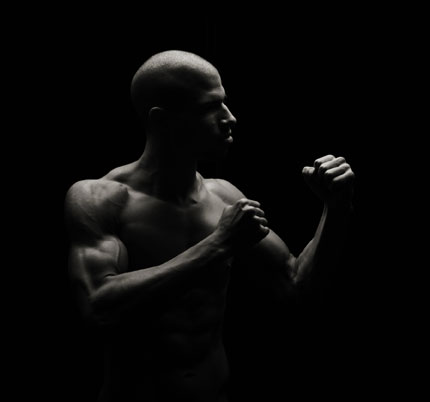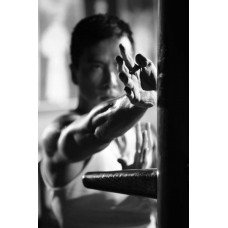Shopping Cart
0 item(s) - $0.00Article | Iron Fist 101 | By Thomas Richard Joiner | 铁掌资料

Iron Fist 101
By Thomas Richard Joiner, 2012 ©
Published in martialforce.com
I think that most martial artists would agree that no matter which style of martial arts you practice techniques like locks, levers, joint dislocation along with a few sweeps and throws and your basic front, side and round kick should all be part of your offensive arsenal. Attention should also be given to developing one’s striking ability because no matter which technique is applied in a given situation, these basic offensive mechanisms are often initiated by a preemptive strike with a clenched fist. The frequency that striking is used as the primary offensive tool to penetrate an opponent’s defense and set-up techniques like those previously described is not surprising when you consider that when the hands (knuckles) are hardened through conditioning, they are a formidable weapon capable of inflicting serious damage to all parts of the body. The predominant use of the hands for striking in the vast array of boxing styles that make up the martial arts underscores the need for conditioning these most often used frequently injured appendages. Needless to say, a technique’s brilliance in terms of its form execution and application is of little value if the striking appendages are incapable of withstanding the force generated at the point of impact. In fact, the argument could be made that anyone who strikes with a reasonable amount of force with hands that have not been properly conditioned are almost guaranteed that the result will be serious injury!
An integral part of the hand and body conditioning tradition that can be traced back thousands of years known as “Small Golden Bell,” the use of Chinese herbal dit da jow has always been an important part of the hand conditioning process for most traditional styles of Karate and Kung Fu. This preventive therapy has always been a critical part of the process in order to minimize the possibility of injuring one self as well as suffering long range negative side-effects such as arthritis, nerve damage and paralysis that can be a result of repetitive striking.
A gradual controlled process… prior to beginning a hand conditioning regimen there have always been basic concepts that need to be considered. Within these principles there are several points that cannot be over emphasized. First and foremost, the student is advised to use herbal medicine (dit da jow) to repair the residual damage associated with all of the different forms of hand conditioning in order to avoid any permanent harm. Secondly, the novice is told to exercise prudence in the amount of training that is undertaken. And lastly, the student is reminded to never forget the wisdom in proceeding slowly. The herbal prescriptions that are used to counteract the process’s inherent negative side-effects contain ingredients that toughen the skin, harden the bones, and prevent blood clots and bruising. Traditionally the dit da jow, which was provided by the Sensei or Sifu, came in two basic forms. There were those containing herbs that relax the ligaments and tendons, toughen the skin and prevent blood clots and bruising that were used in the beginning and intermediate stages of development (known as the Yang external stage), and a separate formula containing herbs that gather the Chi and harden and strengthen bones that was used in the final phase of conditioning (known as the Yin internal stage). In recent years, a practice that has grown in popularity is the practice of combining the two different types of formulas into one. As you can imagine when this is done the single formula that is created usually contains a large number of ingredients, two dozen or more is not uncommon. Developing the iron fist, which is primarily done by striking the Makiwara board, focuses on the knuckles, fore fist (the side of the fist opposite the thumb) and knife hand. Training which is pretty basic, involves striking the wooden Makiwara board as many times as possible with maximum force without sustaining injury. As training progresses, the number of repetitions and the amount of force that is used should gradually be increased over a period of months and years. With persistent practice power should come naturally. The over use of muscular force which is counterproductive to internal conditioning and makes injury much more likely, should be avoided. Striking ability or power will come as a result of learning to relax in order to train your internal structure, direct your flow of Chi and by increasing focus and speed. Daily training should include the use of herbal liniments (dit da jow) before during and at the end of the training session. Supplemental training usually involves doing “push ups” on the knuckles and striking into a bucket filled with sand to toughen the skin.
One of the most well-known proponents of this method of training was the legendary Mas Oyama founder of Kyokushin, who is best known for his ability to knock out a charging bull with a single blow to the head. Master Oyama, who trained exclusively on the Makiwara board is said to have had knuckles capable of withstanding a blow from a hammer or other equally hard metal object. If there is a downside to this type of training it is that hands conditioned in this manner undergo a build-up of scar tissue which causes an increase in the size of one’s knuckles as well as a hardening of the bones. Consequently, the physical appearance of hands that have undergone this type of training make it difficult to conceal the fact that you have martial arts training, thus eliminating the element of surprise! Despite this negligible adverse reaction, hand conditioning is still considered an essential part of training for boxers as well as most traditional Japanese, Korean and Chinese styles.
In closing, I would be remiss if I did not include the warning to those who undertake hand conditioning that the perils associated with hand conditioning are real. However, when prudence is exercised in conjunction with the diligent use of Chinese herbal Hand Conditioning Formulas, the risk of injury and the possibility of suffering the long range side-effects described earlier are dramatically reduced and often avoidable. Typical examples of iron palm/hand conditioning formulas are the legendary Fung Doe Duk’s Coconut Break formula which is a favorite of external stylist, and Mew Hing’s Eighteen Taoist Palms Clouds in Heaven and Golden Lotus a sixth century Buddhist formula which are often preferred by internal practitioners. An added benefit to using these formulas is that they are among the group of hand conditioning dit da jows that can be used exclusively through out the entire hand conditioning process.
Chien,
Thomas Richard Joiner, Kyoshi
Chinese Goju Martial Arts
 Thomas Richard Joiner, author of the Warrior as Healer, Blending Botany and Budo, and Chinese Herbal Medicine Made Easy, is a Kyoshi 6th degree black belt Chinese Goju Martial Arts and has received certification in Tien Tao Chi Kung, as well as being a graduate of the Institute of Traditional Chinese Medicine New York City. He has conducted advanced study in traditional Chinese medicine (acupuncture) as well as Chinese Herbology with Dr. Lai Fu Chai at the Academy of Chinese Culture and Health Sciences in Oakland, CA and continued study in Chinese Herbology at the Institute of Chinese Herbology in Berkeley, CA. Thomas’s martial arts education includes training in Wing Chun Gung Fu with Sifu Ralph Rodriquez, Sifu Lee Moy Shan and the late Grandmaster Moy Yat. In addition he has studied Taoist Esoteric Yoga Micro-cosmic orbit meditation, Iron shirt Chi Kung and Seminal Ovarian Kung Fu with Mantak Chia, as well as training in Chinese Goju Martial Arts under Grandmaster/Shidoshi Ron Van Clief. Sensei Joiner’s books provide extensive insights into the centuries-old practice of incorporating herbs into your martial arts training as well as making available prescriptions for many of the legendary and most highly regarded formulas used in Asian Martial Arts for treating injuries as well as enhancing one’s training. Sensei Joiner has been a practicing Chinese Herbalist for nearly two decades, and is the founder of an online mail order company Treasures From the Sea of Chi which specializes in traditional Chinese herbal formulas used in martial arts training. If you would like more information on ancient herbal practices in the martial arts, Sensei Joiner can be reached at his company email: info@seaofchi.com.
Thomas Richard Joiner, author of the Warrior as Healer, Blending Botany and Budo, and Chinese Herbal Medicine Made Easy, is a Kyoshi 6th degree black belt Chinese Goju Martial Arts and has received certification in Tien Tao Chi Kung, as well as being a graduate of the Institute of Traditional Chinese Medicine New York City. He has conducted advanced study in traditional Chinese medicine (acupuncture) as well as Chinese Herbology with Dr. Lai Fu Chai at the Academy of Chinese Culture and Health Sciences in Oakland, CA and continued study in Chinese Herbology at the Institute of Chinese Herbology in Berkeley, CA. Thomas’s martial arts education includes training in Wing Chun Gung Fu with Sifu Ralph Rodriquez, Sifu Lee Moy Shan and the late Grandmaster Moy Yat. In addition he has studied Taoist Esoteric Yoga Micro-cosmic orbit meditation, Iron shirt Chi Kung and Seminal Ovarian Kung Fu with Mantak Chia, as well as training in Chinese Goju Martial Arts under Grandmaster/Shidoshi Ron Van Clief. Sensei Joiner’s books provide extensive insights into the centuries-old practice of incorporating herbs into your martial arts training as well as making available prescriptions for many of the legendary and most highly regarded formulas used in Asian Martial Arts for treating injuries as well as enhancing one’s training. Sensei Joiner has been a practicing Chinese Herbalist for nearly two decades, and is the founder of an online mail order company Treasures From the Sea of Chi which specializes in traditional Chinese herbal formulas used in martial arts training. If you would like more information on ancient herbal practices in the martial arts, Sensei Joiner can be reached at his company email: info@seaofchi.com.
Article | Iron Fist 101 | By Thomas Richard Joiner—Product: Published Article, 3 pages
Write a review
Your Name:Your Review: Note: HTML is not translated!
Rating: Bad Good
Enter the code in the box below:

All Rights Reserved | © Sea of Chi 2025 | Web Design Company - DreamCo Design
The statements made have not been evaluated by FDA. Our products are not intended to diagnose, treat, cure or prevent any disease.





